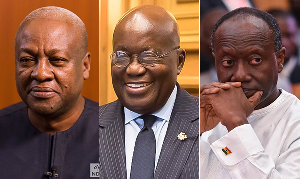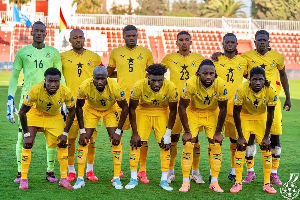Next Wednesday April 27, 2016, will mark the 44th anniversary of the death of Osagyefo Dr Kwame Nkrumah, Ghana’s first President.
It was a sad day for millions of his followers in Ghana and those who believed in his ideals across the continent and others in America and elsewhere in the world who had come to also believe in the African Revolution, fired by no other person than the Osagyefo.
After his overthrow on February 24, 1966, while on a peace mission to China and his subsequent exile in Guinea, where his pal Sekou Toure made him his co-president, many still had hopes that he would one day return to Ghana and take over the leadership of Ghana once again.
Any hopes ardent supporters of the Osagyefo had of his possible return to the centre stage of Ghana politics were however dashed by his sudden demise in faraway Bucharest, Romania, where he was receiving treatment for skin cancer, the result of several bomb attacks on his person when he held power in Ghana.
But before his death, and especially following the overthrow of the government of Dr K. A. Busia on January 13, 1972 by the military, led by then Colonel I. K. Acheampong of the First Infantry Brigade, rumours were rife that the coup that ended the Second Republic was staged to bring back Nkrumah.
Col. Acheampong was known to be an admirer of the Osagyefo and despite his close relationship with Dr Busia, many thought he and his colleagues in the military were bent on bringing back Dr Nkrumah.
The story
Following the persistence of the rumour, the National Redemption Council had to issue a statement on Friday, March 3, 1972 which was carried the following day in the Daily Graphic under the headline “Coup Not For Nkrumah”.
The story ran like this:
“The National Redemption Council has reiterated that the Armed Forces did not remove Dr K. A. Busia with the aim of bringing Nkrumah or anybody else to Ghana. This, the council emphasised, should be clearly understood by all sections of the community.
“In a press statement issued by the NRC in Accra yesterday, the Council emphasised that the January 13 coup was not staged for the benefit of any political party, persons or group of persons.
“The council said its attention had been drawn to rumours that the coup was planned and executed on behalf of the disbanded Convention People’s Party (CPP) for the return of ex-President Kwame Nkrumah”.
Less than two months after this statement by the NRC, Dr Nkrumah died. The way the government handled the announcement of his death and the subsequent arrangements for his funeral left many in no doubt that something different might have happened if the Osegyefo had not died.
On that fateful day, April 27, 1972, I was in my second year of teaching at my alma mater, Konongo / Odumasi Secondary School. Every evening at 6:00p.m., I used to go to the balcony of my flat, with my radio, to go and listen to the six o’clock news.
There was nothing unusual after the highlights had been read that day. I ,therefore, decided to go inside and bring some newspapers to read as I listened to the news. Then the bombshell was dropped.
“Now details of the main news. This is a special announcement. The National Redemption Council (NRC) announces with deep regret the death of Dr Kwame Nkrumah which occurred this morning at Bucharest, Romania at 8:40 local time.
“In appreciation of the significant role which Dr Nkrumah played in the history of this country and Africa in general, the National Redemption Council is considering plans to bring his body home”.
News of Nkrumah’s death
I thought I went blank. It was a shocking news to hear, I was alone in my flat and there was nobody to discuss this with. Even the following morning when we went to school, many teachers had not heard the news.
At that time, we were still some three decades away from the handset when one could have called friends to break the news if they had not heard it. Infact the news would have gone viral before the announcement was made if it were today. Even then, the landline telephone was not effective and very few people had access to the phone at that time.
However, there was no doubt that the government of the NRC was kept abreast of the condition of Dr Nkrumah after he was flown to Bucharest from Conakry. Sekou Toure did not trust the West hence his decision to fly Dr Nkrumah to Bucharest when his condition deteriorated. Col. Acheampong and his colleagues in the NRC followed developments on Dr Nkrumah’s condition until he gave up on April 27, 1972.
The military junta in Accra was hoping that Nkrumah’s body would be flown to Accra following interactions with Conakry. But the body was sent to Guinea three days after his death.
Then began diplomatic manoeuvres by the NRC to convince Guinea to release the body to Ghana for burial. The government of Ghana even went out of the way to solicit the assistance of friendly neighbouring heads of state to intervene in the impasse. Meanwhile, the government of Ghana had fixed Friday May 19, 1972 for the funeral of the Osagyefo.
On Monday May 1, 1972, Radio Nigeria reported that Guinea had agreed to release the body of former President Kwame Nkrumah for burial in Ghana following the personal intervention of the Nigerian Federal leader, General Yakubu Gowon.
Radio Nigeria quoted the Guinean President, Sekou Toure, as saying in a message to General Gowon that his agreement to release Nkrumah’s body was an act of “personal respect for General Gowon”.
According to Radio Nigeria, a personal representative of General Gowon would accompany an official Ghanaian delegation that would take Nkrumah’s body from Conakry to Accra.
The official Ghana delegation to Conakry made a stop-over in Freetown, Sierra Leone to enlist the help of Sierra Leone President, Siaka Stevens, in arranging the body to be sent to Ghana.
Shortly after arrival in Sierra Leone, the Ghana delegation held a 20 – minute discussion with Dr Siaka Stevens, who assured the Ghanaians of his support to get Conakry release the body for burial in Ghana.
Despite all the efforts by the government of the NRC to get the body of Nkrumah to be sent back to Ghana before the funeral, the Conakry government did not release the body.
However, the NRC declared Friday May 19, 1972 as a National Day of Mourning and a Public Holiday for the funeral of ex-President Dr Kwame Nkrumah.
In a television and radio broadcast the night before Col. I. K. Acheampong, the Chairman of the NRC and Head of state announced that a memorial service would be held at the State House in Accra.
Col. Acheampong narrated the circumstances which made it impossible for the body of the ex-President to be brought to Ghana as decided by the Council earlier on. He said Guinea was still angry with Ghana for the overthrow of Nkrumah.
Nkrumah’s body arrives in Ghana
It was not until Friday July 7, when all hopes were lost, and more than two months after his death, that the remains of Dr Kwame Nkrumah, in a glass casket finally arrived in Ghana from Conakry.
It was accompanied by Madame Fathia Nkrumah, widow of the late President and Mr Kojo Botsio one-time Foreign Affairs Minister in the CPP government.
On the special Air Guinea plane which brought the body was a three man Nigeria delegation. The delegation later called on Col. I. K. Acheampong Head of State and Chairman of the NRC at the Castle, Osu.
Before the corpse was removed from the air craft at the Ghana Air Force Base, a representative of the Ga Mantse, Nii Amugi II, poured libation.
Also present at the Air Force Base to welcome the body was Dr Francis Nkrumah, son of the late President and a six-man delegation from the late President’s family led by Minla Ndede.
Next week the focus will be on Nkrumah’s legacy.
Opinions of Monday, 25 April 2016
Columnist: Razak El-Alawa














